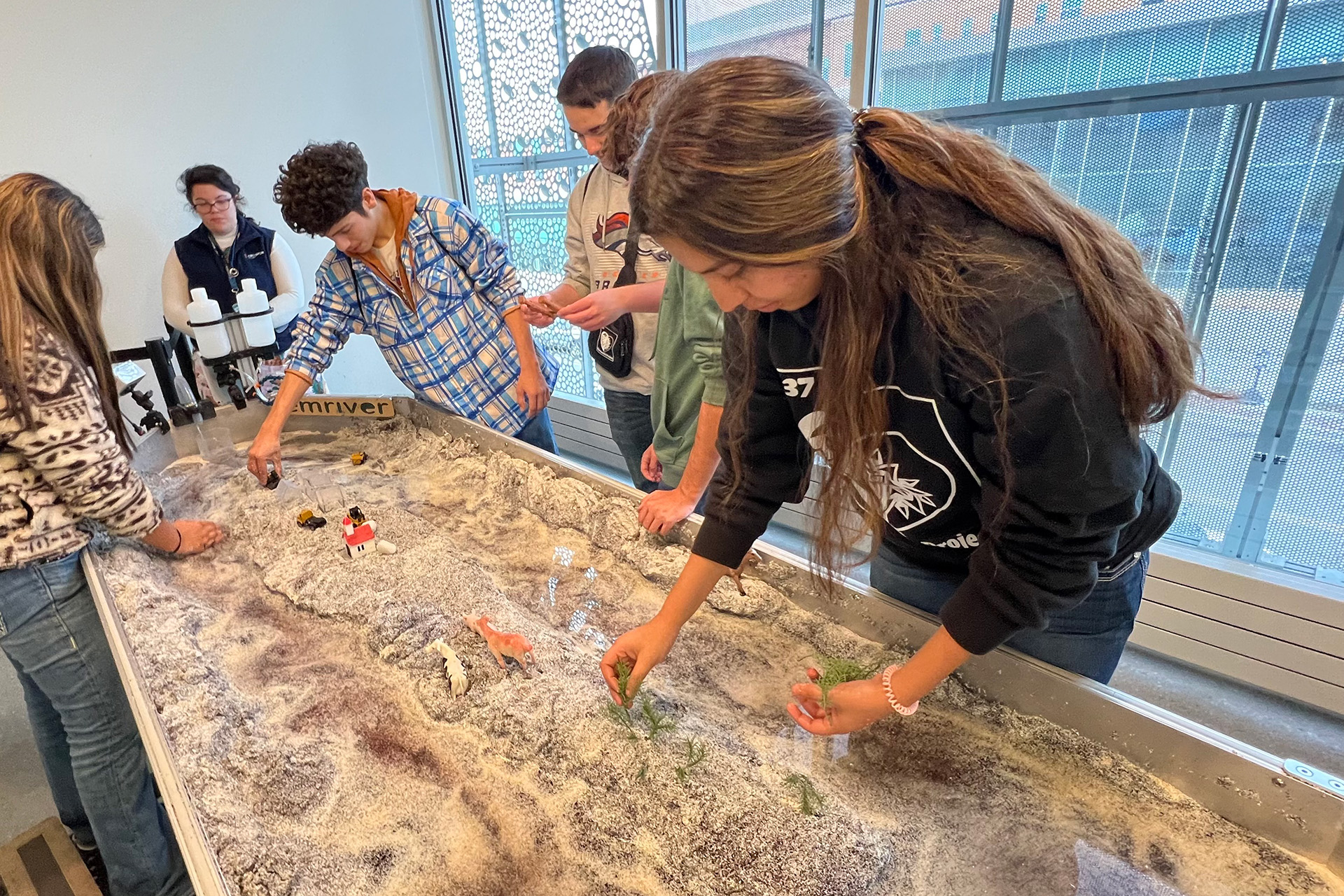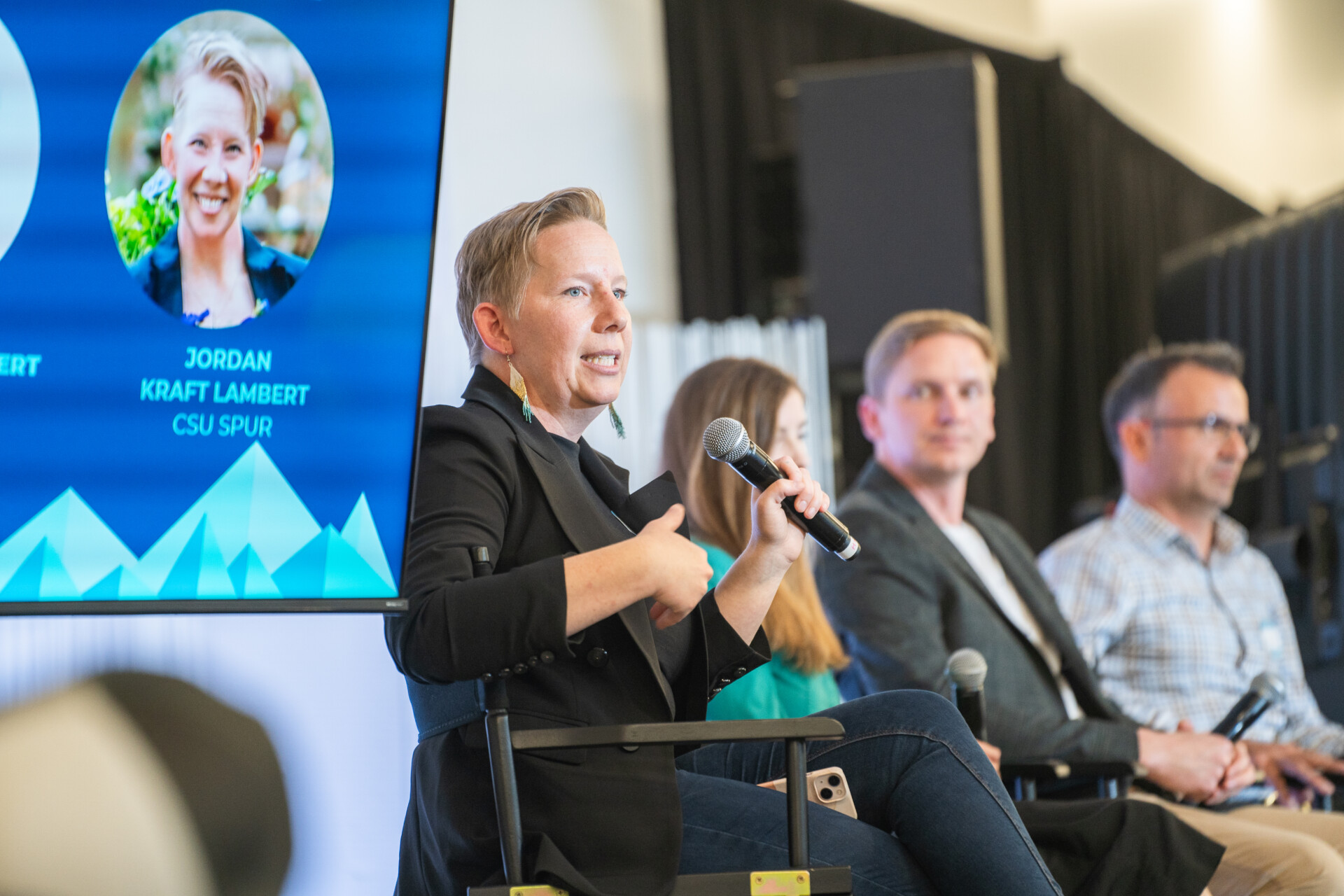A campus for Colorado
How CSU Spur serves the state
story by Anthony Lane
published Jan. 4, 2024
For some members of a Colorado leadership group, what stood out after visiting CSU Spur this past June was the focus on agriculture, from innovation in research and entrepreneurship to cultivation of the next generation of thinkers and doers.
A NASA scientist in the group came away inspired by connections across a campus oriented toward problem solving in the areas of food, water and health. Several educators commented on the “unique perspective” of looking toward the future to see what changes are happening or are needed.
Later, a few members of the group told Kathay Rennels – special advisor to the Colorado State University System chancellor for rural-urban initiatives who was then serving as interim vice president for Engagement and Extension – that they’d already returned to CSU Spur since that first visit. One explained he had wanted to show his daughter, a teacher in New York, how the campus lets children discover career options and educational pathways that connect with their own interests.
And that’s just people who, like Rennels, are part of Colorado Cooperation, a group of leaders and “influencers” that formed in the late ’90s and still meets regularly to build understanding and solidarity across the state. Around the same time, Rennels, who previously served as a Larimer County commissioner, also met at Spur with a group of commissioners representing Colorado counties both rural and urban. Their responses were similar.
“I guess it’s a composite of people coming in and seeing at Spur a different vision, and finding it valuable in different ways,” Rennels said. “That is actually what we want. We want it to be dynamic and unique, and then to be able to meet the needs of the future.”
Meeting the needs of the future is a tall order, and it begins with serving the state. Beyond the programs and initiatives of the CSU System campuses, CSU already has a network of Extension offices, agriculture research centers, Colorado State Forest Service offices, and other facilities stretching across the state and serving each of its 64 counties.
Rennels describes a thriving “symbiotic relationship” involving CSU Spur and Extension. CSU Spur draws on insights from Extension programs from 4-H and Master Gardeners to Agriculture Business Management and Soil Health, and it also centralizes expertise so that a single demonstration, perhaps involving how to match soil types with grass varieties, can be sent out across the state. At the same time, Spur can be a hub for statewide programming, including in January, when 4-H members from across the state and region will gather at the campus for the Western National Roundup before the National Western Stock Show begins Jan. 6.
CSU Spur has a similar role enhancing CSU’s statewide agricultural research, explained Eugene Kelly, a CSU professor of soil science and deputy director of the Colorado Agricultural Experiment Station. In addition to serving as the site of the newly formed Metropolitan Ag Research Center, CSU Spur functions as a sort of nerve center for statewide efforts to monitor, track and respond to crop disease, pest outbreaks and changing conditions.
“It allows us to do a better job of looking at trends and patterns that are going on statewide,” Kelly said. “This is a much more powerful approach for creating resilient agricultural systems.”
Eye-opening experiences
Since CSU Spur started welcoming visitors in January 2021 with the opening of the Vida building, focused on human and animal health, the campus has hosted close to 11,000 K-12 students as part of facilitated school visits. The pace of visits accelerated over the following year as construction of the campus concluded with the opening of the food-focused Terra building in June and then the water-themed Hydro building in January 2022.
To date, schools from 15 Colorado counties have made the trip to CSU Spur, arriving by bus from as far away as Phillips County, near the state’s northeast corner, and Bent County, to the southeast.
On a recent Wednesday, 27 high school students from Rocky Ford, a city 50 miles east of Pueblo that proclaims its status as Colorado’s “sweet melon capital,” gathered at Spur for a tour, activities and presentations on career possibilities in and beyond agriculture. Representatives from Nutrien, the world’s largest provider of crop inputs and services, talked about the range of jobs involved in the fertilizer business alone, from mining and processing to sales and administration.
Later, the conversation touched on how technology is changing many agriculture jobs while also creating new ones. In several industries, for example, drone pilots are in demand for their ability to quickly gather data and images from remote areas.
Since Rocky Ford Junior-Senior High School is one of 10 public high schools in CSU’s Alliance Partnership, Rocky Ford students who go to the university already receive a base scholarship of $4,000 a year. Elias Quiñonez, manager of student life and diversity for CSU’s College of Agricultural Sciences, explained there are other types of support available, and the college has even provided funding for students to get their drone pilot licenses.
Teresa Walz, a Rocky Ford vocational agriculture teacher who accompanied the students on this and a previous visit to CSU Spur, expressed excitement about getting even more students to visit.
“They have to have these eye-opening experiences,” Walz said. Her motivation to make such experiences available comes from what she learns working with the students each day: “You can see the potential in these kids.”
The Rocky Ford visit occurred as part of the College of Agricultural Sciences’ Semilla Project, which operates out of CSU Spur and aims to boost diversity in STEM, and particularly in agriculture, by exposing students from partner schools to hands-on learning, with a particular focus on career exploration. Quiñonez has developed the program through partnerships with Colorado GEAR UP, a pre-collegiate grant program, and through CSU’s Native American Cultural Center.
The program is designed to reach students whose families may have long connections to agriculture, but for whom the full range of agricultural, academic and life possibilities might not be apparent. For students who continue on to CSU, the aim is to provide ongoing support and access to enriching activities, including internships, summer experiences and research opportunities.

“We’re going to be game changers, and it’s going to start off by honoring the families,” Quiñonez said. He explained that the Semilla Project, which makes use of the Spanish word for “seed,” is part of a larger vision: “We know that access without support is not access. We can get them here, but if they don’t see other students like them, or they don’t see any cultural influence at all, they might last a semester or a year, and then they are out.”
Toward the end of the Rocky Ford visit, students in small groups used their artistic skills and marketing savvy to design packages for their imagined food creations. Quianna Ruiz, 16, a sophomore and officer with Future Farmers of America, briefly broke away from her group to confer with Mo Walsh, education staff and volunteer coordinator at CSU Spur, about how to develop her interest in zoology. Walsh, who came to Spur with a decade of experience at zoos in Denver, Pueblo and elsewhere, gave her ideas about how to find opportunities and gain experience.
For many Colorado students, the CSU Spur experience waits at the end of a long bus ride. Over time, virtual learning options and online resources will increase accessibility, and professional development opportunities at Spur for science and environmental educators will provide classroom teachers with fresh ideas.
Through a partnership with CSU Spur, the CSU College of Veterinary Medicine and Biomedical Sciences’ “Sci on the Fly” mobile outreach lab is bringing research to a statewide audience, and Spur is a hub to put problem-based STEM Kits, developed by the Natural Sciences Education and Outreach Center, into an expanding circle of classrooms. CAM’s Ag Academy, offering programs at Spur’s Morgridge Learning Lab, is also focused on problem-based learning, with programming aimed at building agriculture interest and literacy among middle and high school students.
“The important piece here is that there are these two different approaches that we’re taking,” said Jim Bradeen, CSU’s associate vice president for CSU Spur strategy. “One involves bringing students to Spur, and the other bringing Spur programming across the state.”
Outside the lines

With its location on the grounds of the National Western Center, CSU Spur is adjacent to the exhibitions, rodeos and events that give a celebratory vibe to the National Western Stock Show each January. Early in this year’s Stock Show, a playfully named event at CSU Spur will highlight a challenge confronting many of the state’s “craft” beef producers: what to do with organ meat.
While large-scale producers can profitably ship these organs, referred to as offal, to countries where there are markets for them, smaller producers, many of which sell directly to consumers, often send these products to the landfill once they run out of freezer space or an appetite to eat them. That’s bad on many levels, explained Jordan Kraft Lambert, CSU’s director of agricultural innovation and partnerships.
“They’re going to get a bill for sending that to a landfill, and when it goes to a landfill, it’s going to rot,” Lambert said. “And when it rots, we are not only losing the incredible nutrition associated with those organ meats, but we’re also emitting methane, which is one of the more powerful greenhouse gases.”
The “Offal Party” on Jan. 7 at CSU Spur’s Hydro building is an attempt to start building the local market for organ meat by serving it up as a culinary treat. The event emerges from CSU Spur’s mingling of academic programs, its focus on problem solving and business development, and its attention to intricacies of communications, outreach and connections. Through the Ag Innovation Center at CSU Spur, Lambert works with start-up companies that are developing technologies to make agriculture more sustainable and resilient.
For Lambert, Spur’s design, which places researchers from across disciplines next to entrepreneurs and within sight of the broader public, helps propel this work. “That’s what I love about innovation,” Lambert said. “There are no lines.”
Recent events highlight the pragmatic benefits of looking beyond lines. Jim Ehrlich, executive director of the Colorado Potato Executive Committee, points to the COVID pandemic, when empty shelves in supermarkets demonstrated how the supply chain is an essential part of the food system.
While technology has allowed ever fewer workers to feed a growing population, an important downside, in Ehrlich’s view, is that “people have lost their connection to agriculture.” He sees CSU Spur is part of an effort to counter that trend by embracing a wave of public excitement about food. “The potential there is amazing to expose the general public to agriculture and educate them about why we do what we do, and how their foods are produced,” he said.
Colorado, for example, is the second largest fresh-market producer of potatoes in the country, Ehrlich said. This is thanks to the efforts of about 150 potato farmers, most of them working farms in the state’s San Luis Valley. CSU researchers are partners in that work, developing new varieties of potato that can thrive with less water or fertilizer, and working with farmers on strategies to manage diseases and pests.
Kelly agrees with Ehrlich on the important role CSU Spur can play in educating the public about the impact of agriculture in the state, from the peaches of western Colorado to the melons of the Arkansas River Valley and the extensive cattle ranches between and around them.
Yet, beyond educating the public about agriculture’s role, and inspiring young people to discover new career options, CSU Spur is about advancing research and finding solutions all related to sustainability, food, food, water and health.
“It really is a hub for creativity,” Kelly said. “You know, all of the intellectual ecosystems intersect there.”